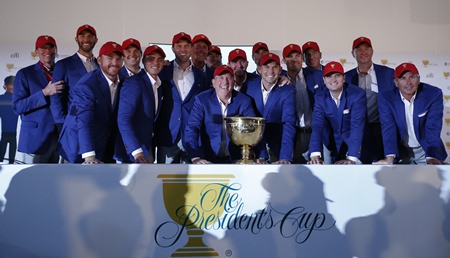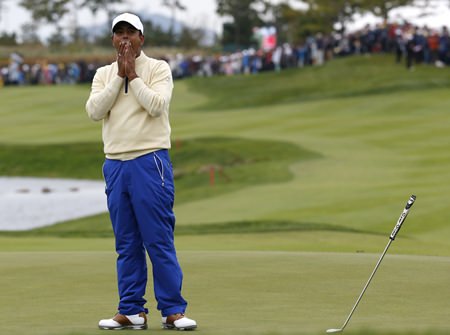The biennial golf match played between Team USA and a team representing the world minus Europe, reached its thrilling climax at Incheon, South Korea, on Sunday 11 October. The event was concluded when Sang Moon Bae conceded on the 18th, thus handing American Bill Hass his win, and the Americans a 15.5 to 14.5 overall result.
Hass was just one-up playing the 18th. With these two being the last match out, and team scores tied at 14.5 apiece, this match seemed to encapsulate the whole tie in terms of the suspense provided. Such had been the one-sided nature of past contests that many wondered whether the event would survive. Based on this last encounter, it certainly will.
 US team captain Jay Haas (front centre) poses with his team after they defeated the International team to retain the Presidents Cup at the Jack Nicklaus Golf Club Korea, in Incheon, South Korea, Sunday, Oct. 11. (AP Photo/Woohae Cho)
US team captain Jay Haas (front centre) poses with his team after they defeated the International team to retain the Presidents Cup at the Jack Nicklaus Golf Club Korea, in Incheon, South Korea, Sunday, Oct. 11. (AP Photo/Woohae Cho)
There are countless reports on the standard of golf played, the excitement created by the match-play format, and who beat whom and by how many. But one story perhaps not covered to the degree it deserves is the one involving the arrogance displayed for many years by the PGA Tour; arrogance that nearly sucked the life from this otherwise deserving event.
As dominant a player in golf as it is the PGA Tour still does not possess a big one; a genuinely huge golf event that makes the sporting world really sit up and take notice. Unlike the body from which it was sprung – the PGA of America – the PGA Tour does not own a major, nor does it have a 50 per cent interest in the biggest golfing event on the planet; the Ryder Cup.
When it became obvious that the PGA of America’s share of Ryder Cup earnings was huge, the PGA Tour decided to jump on the match-play bandwagon by creating the Presidents Cup in 1994. The biennial event was to take place in years when the Ryder Cup didn’t. It was a match played between the United States and the rest of the world, except Europe.
Since inception, the US has lost just once to the internationals; a side that has not come remotely close to winning since a tied event in 2003; 12 years ago. Not only have the results proved lopsided, but the event has lacked the type of drama that has come to define the level of competitiveness that is the Ryder Cup. The reason – a one-sided format – has been obvious to any follower of match-play golf, and has been pointed out, repeatedly, to the PGA Tour.
 International team player Anirban Lahiri of India reacts on the 18th green after missing a vital putt to lose his singles match against United States’ Chris Kirk. (AP Photo/Lee Jin-man)
International team player Anirban Lahiri of India reacts on the 18th green after missing a vital putt to lose his singles match against United States’ Chris Kirk. (AP Photo/Lee Jin-man)
Unlike the Ryder Cup, the Presidents Cup has only one owner who makes all decisions. Unlike the Ryder Cup, the Presidents Cup format made 22 points available in team matches, making it easy for the team with greatest depth in numbers to get so far ahead that the last day’s singles matches, all 12 of them, could and often did become an irrelevancy. Unlike the Ryder Cup, which limits all team matches to eight players (each team required to rest four), the Presidents Cup up until this last event did not rest any. Unlike the Ryder Cup, the Presidents Cup has, mostly, not been a competitive event; until now.
Because the US has traditionally boasted the greatest depth in playing strength, the more players involved each day, the more likely Team USA would win. And win it did. So often and by such large numbers that interest in the event became dangerously low.
Years of complaints from the likes of Ernie Els, Greg Norman and Nick Price fell on deaf ears until, it appears, Price’s uttering of 2013.
Shortly after being named as captain of the international team for the 2013 event, he was asked would he consider accepting the position again in 2015, scheduled for South Korea. Price replied, “I’d love to be but I don’t know if I would do it under the current points format. Hopefully they will do something about it. We’ll see.”
Price had suggested to PGA Tour Commissioner Tim Finchem that as many as six matches be eliminated from the competition. This would allow the captains to sit out certain team members in each session and create better matchups. Price was repeating what many had stated over the years, so why wasn’t the PGA Tour acting on what was being said?
Having conceived the format, the last thing the PGA Tour wanted was the accusation of a Ryder Cup lookalike, a poor-man’s copy if you will. They wanted their own unique product that would appeal to American audiences and American sponsors. That meant that Team USA had to win. And in that formulae lay the recipe for failure as they overlooked the most important factor of all; the thing that makes the Ryder Cup such a huge drawcard; competitiveness of the highest order and the drama it brings.
Finally, in August this year PGA Tour Commissioner Tim Finchem announced changes that Nick Price et al had been pleading for. The changes meant two players dropping out of the team events, meaning the captains would name ten players for team matches from the 12 available. Not quite a Ryder Cup copy, but closer.
The result; a thrilling tie that went all the way to the last hole in the last game on the last day. A result which gave us golf of a type that could well see resurgence in interest, world-wide, in an event that had become a non-event on the golfing calendar.
Why did the PGA Tour take so long to fix what was an obviously broken format? One suspects arrogance, and the possibility they placed the perceived need for constant US victory above the need for true competitiveness – not a good idea in a match-play event, just ask Jack Nicklaus!
Golfnutter.




